Use 'Print preview' to check the number of pages and printer settings.
Print functionality varies between browsers.
Printable page generated Thursday, 25 April 2024, 1:08 AM
Hygiene and Environmental Health Module: 11. Hygienic Requirements of Food and Drink Establishments
Study Session 11 Hygienic Requirements of Food and Drink Establishments
Introduction
Food and drink establishments are places where an individual gets food in the form of breakfast, lunch, dinner or snacks, accompanied by some form of drink. Unhygienic practices in food and drink establishments affect the health of the clients. In this session, you will be introduced to the hygiene requirements in food and drink establishments that are likely to be found at kebele level. You will learn how food items and equipment are handled in a hygienic manner, the public health importance of food handlers, and what client-focused hygienic services are required.
Learning Outcomes for Study Session 11
When you have studied this session, you should be able to:
11.1 Define and use correctly all of the key terms printed in bold. (SAQs 11.1 and 11.2)
11.2 Describe the categories of food and drink establishments. (SAQ 11.1)
11.3 Explain the hygienic requirements that are applicable in food and drink establishments. (SAQ 11.2)
11.4 Explain the hygienic behaviours required of food handlers. (SAQ 11.3)
11.5 List the sanitary facilities required in food and drinking establishments. (SAQ 11.4)
11.6 Describe the procedure for sanitary inspection in food and drinking establishments. (SAQs 11.2 and 11.3)
11.1 What is a food and drink establishment?
Food and drink establishments provide food and drink services to a relatively large number of users in the form of breakfast, lunch, dinner or beverages. Formal food and drink establishments are authorised to practise this service after being licensed by the local authorities. There also exist a number of informal food and drink establishments that provide a service without much interference from the local government. Food and drink establishments have a responsibility to provide safe food and drink to the consumers. The consumers have the right to demand safe food. If food is not prepared and handled in hygienic conditions, it spreads foodborne disease that could affect a large number of people at a time.
The local government (kebele) takes actions to ensure the hygienic functioning of these establishments on behalf of the public. The Ethiopian Regional and National hygiene and environmental health regulations can be exercised in the kebele by the presence of an appropriate expert who is authorised to enforce them. As a Health Extension Practitioner you can make a link with this authority through regular reporting to ensure that the necessary actions are taken to maintain safe practice.
11.2 Categories of food and drink establishments
There are several types of food and drink establishment in rural areas. Some may provide only food; others provide food and drinks such as soft drinks, beer and other alcoholic drinks; some provide only snacks and hot drinks. We describe below those establishments that are likely to be found at kebele level.
- Restaurants are food establishments that provide lunch and dinner (Figure 11.1) with accompanying drinks.
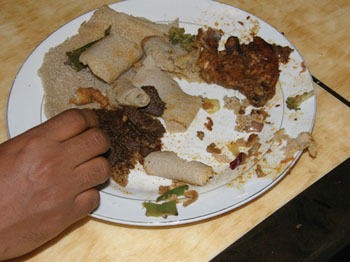
- Cafés provide hot drinks and snacks. Hot drinks include tea, coffee, milk, or a blend of milk and coffee (macchiato). The café must have water boiling equipment for coffee and tea preparation. Cakes and doughnuts (such as bombolino, chornake and sambusa) are served as snacks.
- Tea houses provide tea and snacks. Snacks are usually plain bread, sambusa and bombolino. Tea is served after mixing with boiled water in a kettle.
- Tej bet is a drink establishment that offers a local light alcoholic beverage made of fermented honey in water, called tej, which is served in large measures.
- Tela bet is an establishment that provides a local light alcoholic drink called tela. They are common in rural areas of Ethiopia.
- Areki bet is a drink establishment that provides a local drink containing more alcohol than tela or tej. It is consumed in smaller quantities.
- A grocery is an establishment that provides packed food and drink items. Groceries may also provide hot dishes.
- A butcher’s shop is a food establishment that offers meat for sale (Figure 11.2).
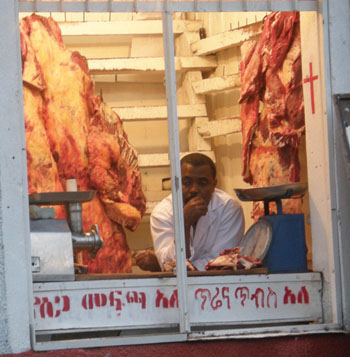
- A bakery is a food establishment that offers plain bread for sale.
- A hotel is a food establishment that offers food, drinks of all types, and bedroom services. The capacity of service and the quality of foods and bedrooms in a rural hotel are less than those of urban hotels.
Take a walk around the centre of your kebele or around the kebele office. List the number and types of food and drink establishments you observe. Categorise them according to the kind of service they offer.
The number of food and drink establishments in rural kebeles is commonly less than ten. Likely types are tea houses, tej bet, restaurants and small groceries.
11.3 Hygienic requirements of food and drink establishments
This section outlines the basic hygienic requirements that are applicable for the food and drink establishments found at the kebele level. Knowing them will help you to make decisions when visiting them for inspections.
11.3.1 Licensing
There should be a system for licensing food and drink establishments in kebeles. The woreda health office is responsible for this licensing system. As the local Health Extension Practitioner, you may be requested to do a preliminary assessment to check the hygienic requirements and report to the woreda health office. Most categories of food and drink establishments can be licensed, though tela bet and areki bet do not require it because of their lower level of health hazards. Please note that the licensing procedure must follow regional and local regulations.
11.3.2 Location of the food establishments
Food establishments need to be well away from any source of hazards such as marshy areas, waste disposal sites and flooding. The site must be conveniently accessible to staff and consumers. The establishments should be at a distance from public institutes such as schools and health facilities. Access to clean air and natural lighting is also important.
11.3.3 Condition of the building
The space available must be adequate to provide the kind of service that the establishment carries out. Depending on the nature of the establishment, the space may include a kitchen, dining room, drinking room, food storage sites, and a utensil washing site. Building structures and their interiors should permit good hygienic practices, including protection against cross-contamination of food surfaces between and during operations. The provision of a window for each room should ensure adequate lighting.
Structures within processing establishments should be soundly built of durable materials and be easy to maintain, clean and, where appropriate, disinfect. Floor and wall surfaces must be cleanable and washable. The surface of the walls must have a light colour that maximises the interior lighting. The roof must be cleanable and maintained free of dirt.
Dining rooms and coffee or tea drinking rooms
The dining room should be very attractive in terms of its cleanliness, lighting and natural ventilation. The cleanliness of the walls, floor and ceiling must be acceptable and the chairs and tables must be in good repair. Food remains must not be dropped on the floor but should be collected and disposed of in a garbage container. The provision of an appropriately sized garbage container, about 10–15 litres, is important.
Hotel bedrooms
The principles of healthful housing that you have learned about in Study Session 4 are also applicable to hotel bedrooms. The cleanliness of the bedding (sheets, blanket, hard surfaces), floor, walls and ceiling are important. A chair and table are also useful for the client’s comfort. A small waste bin must be available. Good ventilation and lighting are also essential components of a hygienic bedroom.
11.3.4 Sanitary facilities
Food and drink establishments need to offer sanitary facilities, which means handwashing facilities, latrines and urinals. The handwashing facility must have soap; a liquid soap is appropriate if this is available. Separate latrines for men and women are desirable. The number of these facilities depends on the number of clients visiting at peak hours. Generally, one handwashing facility and latrine for 30 clients is appropriate.
Food handlers should be provided with a separate latrine, handwashing and changing facilities at a convenient location. The availability of soap is essential for proper handwashing (Figure 11.3).

11.3.5 Access to water
Food and drink establishments require a sustained source of safe water to be used for personal hygiene, food preparation and utensil cleaning. A water tank is one option to ensure the availability of water at all times.
11.3.6 Waste management
Food and drink establishments produce organic wastes such as food remains, and liquid wastes as a result of hand and kitchenware washing. These wastes need to be handled properly without contaminating or polluting the immediate environment. Specific information on waste management can be found in the study sessions later in this Module.
11.3.7 Kitchen and food preparation site
The space and layout of the kitchen must be appropriate to accommodate the food preparation and kitchen processes. There must be separate sections for raw food preparation and handling cooked food.
Why is it important to keep cooked and raw food separate?
The raw food will contaminate the cooked food if they touch each other.
The presence of a window and a chimney is essential in order to manage the indoor air pollution that is caused by biomass fuel burning.
The presence of facilities for washing hands and kitchenware is mandatory in a kitchen. Proper shelves for physically separating soiled and cleaned items are also a necessity.
The proper handling of kitchen refuse and liquid waste controls the spread of infestation and food contamination. Food scraps and leftovers must be placed in a covered container. The floor and tables need to be cleaned frequently during the processes of food preparation and cooking.
11.3.8 Cleaning dishes, drinking utensils and cutlery
The cleaning of soiled dishes is an important way of preventing communicable diseases. There is an established procedure that the person who is the dish washer must follow. ‘Dish’ in this section includes plates, cups, glasses, spoons, forks and other utensils.
The three bowl method for cleaning soiled dishes
The manual cleaning process requires three vats or bowls, each with a capacity of 20–30 litres (Figure 11.4). Washing equipment such as detergent (powdered soap) and a scraping cloth, sponge or cleaning brushes are also necessary.
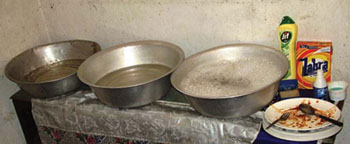
The procedure shown in Box 11.1 uses the three bowl system, which is recommended for the rural setting where running water is unlikely to be available.
Box 11.1 Dishcleaning guidelines where there is no running water
- Decide what to wash first: generally it is best to start with glasses and cups. However, the following description is for washing soiled plates.
- Fill the first two bowls halfway with warm water (50ºC). Hot water (80ºC or above) is added to the third bowl. A detergent must be included in the first bowl.
- Scrape the food from dish surfaces and collect it in a garbage container. Place the dish in the first bowl and wash with the detergent until the grease has gone. Washing plate by plate increases cleaning efficiency. Then place the washed item into the second bowl.
- Rinse the dish well in the second bowl. Any remaining food particles and soap must be taken away by thorough rinsing. Then place the dish into the third bowl.
- The process of dish washing in the third bowl is called sanitising which is a procedure to inactivate and remove the microorganisms that may be found on the surface of the dish. Sanitising is possible by rinsing the dish in hot water at a temperature of 80ºC for one to two minutes. Rinsing in warm water that contains chlorine (50–100 ppm) can replace the use of hot water. Immersing the rinsed dish for 15 seconds adequately sanitises.
- Dry the dish with a clean cloth or air-dry it. The cleaned and dried dish is then placed in a shelf or rack that has a cover. Dishes must be kept under cover until used. Remove dishes that are not in good condition and replace them with new ones.
- The water used for washing must be changed frequently as needed. The used water in the first bowl is more frequently changed than that in the second bowl. Continued use of dirty water must not be encouraged. The water temperature in the third bowl must be kept high.
Note that ppm stands for parts per million. It is a measure of the concentration of a substance in a solution.
Washing cups, glasses and spoons
The principle of cup washing is the same as that of washing soiled dishes. The three bowl system should be encouraged but two bowls is also acceptable, with warm water and detergent in the first bowl and hot water in the second. The first wash cleanses the grease, while the second bowl sanitises the cups. Cups must be dried with a clean piece of cloth or air-dried before use.
The glass-washing facilities for birle in tej bet should use a three bowl system. The first is used for washing with detergent, the second and third for rinsing.
When cold and hot running tap water is available, sinks with two compartments/bowls are sufficient because the hot running water is used for rinsing and sanitising (Figure 11.5).
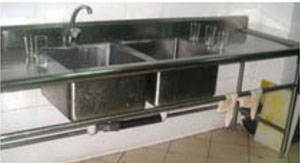
11.3.9 Maintaining hygienic kitchen equipment
All surfaces that come into contact with food should be constructed of appropriate materials and be well-maintained, for example, wooden boards must be smooth and metal tables should be plain and not corrugated. Any surface that is cracked, scored or has an irregular surface is difficult to clean and may harbour dirt. Chopping and cutting blocks for preparing meat or vegetables must be kept clean and covered. All utensils and equipment must be protected from possible contaminants including dust, dirt, insects, rodents and overhead drips. Equipment and food containers should be made of materials with no toxic effect and be designed to ensure that they can be easily cleaned, sanitised and maintained.
Surfaces such as chairs and tables that do not normally come into contact with food should also be clean and in good repair. Always use clean cloths to cover tables and change them whenever necessary.
11.3.10 Storing and serving foods
Perishable food items are easily spoiled if stored at room temperature. Foods such as meat should be kept in a refrigerator that can keep the temperature below 10ºC. Semi-perishable foods, such as potatoes and carrots, which are used on a daily basis, need to be stored on a well-ventilated shelf. Shelves must be 50 cm from the ground and well away from wall surfaces. A distance of 1 metre is adequate between shelves. Serving food to consumers should provide maximum health protection. Hot foods should be served while they are hot, and cold foods while they are cold. Foods must be thoroughly reheated if they have been at room temperature for longer than 1 hour.
11.3.11 Vector control
Vector management is a challenging task in food establishments.
The control of these vectors was described in Study Session 6.
What vectors are you likely to find in kitchens and food storage areas of food and drink establishments?
Flies, cockroaches and rats are commonly observed in these places.
11.3.12 Meat handling and butchery
Butchery may be available in kebeles. The food handler (butcher) must satisfy the hygienic practice of personal hygiene. The meat must be from approved sources, be fresh and be sold within one to two days. The handling of meat needs to be in a well-ventilated area and the presence of flies around the meat must be controlled. Knives, chopping boards and wrapping materials must be clean; the use of newspapers and similar items for wrapping must be discouraged. The walls, floor and ceiling must be free from any dirt.
11.4 Food handlers’ health and hygiene
As you have learned in previous study sessions, food handlers are a common source of foodborne diseases. The practice of good personal hygiene that you learned about in Study Session 3 is essential for anyone who handles food, especially in food and drink establishments where many customers could potentially be affected. A sick food handler with symptoms of diarrhoea, eye and ear discharges, skin infections, open cuts and wounds, or coughing should not continue working. They must be treated and be completely recovered before returning to work.
What are the main principles of food handlers’ hygiene?
To protect food from contamination and to protect the health of the consumers.
Food handlers must use personal protective devices such as clean aprons, overalls or gowns, footwear, and hair cover. As a Health Extension Practitioner you should be involved in training food handlers on food safety. The strict rules of handwashing after using the latrine or touching dirt and before handling food must be followed. Box 11.2 indicates some bad habits of food handlers that should be avoided.
Box 11.2 Unhygienic practices by food handlers
- Poor personal hygiene practice.
- Unguarded coughing or sneezing.
- The habit of licking the fingers.
- Nose picking or fingering the nose.
- Handling of handkerchiefs.
- Working in street clothing.
- Spitting in food-handling areas.
- Uncovered hair.
- Smoking in kitchens.
- Ignoring handwashing before starting work, after handling contaminated materials, after breaks and after using toilet facilities.
11.5 Sanitary inspection in food and drink establishments
Health Extension Practitioners have the responsibility of safeguarding the health of the public by ensuring safe hygienic practice in food and drink establishments. Inspecting the food establishments (sanitary inspection) is a means of identifying or monitoring unsafe practices of food handling.
11.5.1 What is the purpose of the inspection?
Sanitary inspection is a set of activities concerned with the preservation of public health and the investigation of environmental hazards in food establishments. Sanitary inspection aims to investigate and detect:
- Food spoilage and its sources.
- Food contamination and its sources.
- Provision for hygienic procedures (dish and handwashing, food storage).
- Provision of sanitary facilities (latrine, water, shower, handwashing).
- The proper location of the establishment.
- The hygienic practice of food handlers.
- Proper waste management (storage, collection and disposal).
- The presence of vectors.
Sanitary inspections are carried out for two reasons: first, to provide education and advice to the owners, and second, for the purpose of providing a licence if you are asked to do so in the absence of the woreda environmental health worker.
11.5.2 When to inspect
There must be a baseline survey of food and drink establishments using a survey checklist. Appendix 11.1 (at the end of this study session) is an example of the sort of surveillance form you could use for your survey. The survey result must enable you to classify the food establishments by hygienic status and to set priorities for inspection. The number of food establishments in your kebele determines the workload of the inspection. You do not have to inspect tela bet and areki bet, as noted above, because of their lower hazard level. Each food establishment should be inspected at least once every year. However, since the number of food and drink establishments in the kebele setting is probably low, often less than ten, then inspecting each four times a year should be possible.
11.5.3 Informing the owners about the sanitary inspection
It is always useful to warn the owners about your inspection visit, including the date, time and purpose. This is useful because your job is promoting food safety and hygienic practice, and your warning may encourage them to check and improve their practices. The kindness and help you get from the owner will facilitate your decisions about the appropriate hygienic instructions to give.
11.5.4 How and what to inspect
Upon arrival at a food and drink establishment you should introduce yourself and announce politely the purpose of your inspection in order not to embarrass the owner. Interviewing food handlers, physical observation and the use of a checklist are the main tools for data collection. Information is also collected by interviewing the owner and the food handlers. The sanitary inspection checklist in Appendix 11.1 can be used for subsequent visits as well as the baseline survey.
The inspection starts by checking the physical presence of latrines and handwashing facilities meant for the clients. The inspection is based on the food preparation flowchart and is carried out in a sequential manner: food storage, kitchen, dining room and drinking rooms (Figure 11.7).
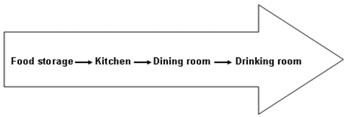
The handling of raw food is inspected in the food storage room. The use of refrigerators for perishable food items (meat, eggs, juice, fruits and vegetables) is checked. Semi-perishable foods such as potatoes and onions need to be stored on shelves that are properly ventilated and free from any vectors.
In the kitchen the use of detergents, the presence of three dishwashing bowls (or a sink with running water) and the practice of personal hygiene must be closely checked. There should be no vectors such as flies and cockroaches in the kitchen area. The food handler’s health is rapidly checked by doing a physical examination for the presence of active infections (skin, eye, ear infections or nasal discharges). The proper use of apron, gown or overalls, hair cover and appropriate footwear by the food handler is also investigated.
The strict separation of kitchen tables for cooked food items and raw food needs to be inspected. The presence of obvious indoor air pollution is also important to note.
In the dining room, the condition and cleanliness of the tables, chairs, floor, walls and ceiling should be observed. The presence of vectors and proper waste management facilities must be inspected in all parts of the food processing and serving areas. The proper handling of kitchen waste in a garbage container, and the presence of a waste bin in dining areas, should be checked.
As you make your inspection, record the information on the checklist. Do not write much on the checklist while inspecting because the owner may not be comfortable about it. Pay attention to critical situations such as dishwashing practice, handwashing practice, vectors and waste handling.
11.5.6 Concluding the sanitary inspection
Discuss your findings with the owner, and explain what hazards and unacceptable hygienic practice you have found. Please also point out what is good. Explain clearly your suggestions for improvement and the urgency of the timescale. It is important that you educate and persuade the owner to implement your advice. Tell the owner that you may revisit the food establishment in future to check what has been improved. You need to keep all the inspection reports for future reference and you should report to the kebele and woreda offices if improvement is not achieved after repeated efforts.
Activity 11.1 Sanitary inspection in practice
Sanitary inspection needs proper planning in terms of the purpose, timing, date and what to inspect. You need to know the sanitary requirements of the food establishments you want to inspect. At your next inspection, use an inspection checklist or survey questionnaire, which as you have seen is the basic tool for data collection. In addition, check for yourself that you can carry out the inspection in a methodical way. Did you find the checklist helpful?
Summary of Study Session 11
In Study Session 11, you have learned that:
- There are several kinds of food and drink establishment that provide food and drinks to the public.
- The operation of food and drink establishments needs to meet basic hygienic requirements in order to safeguard the public.
- The Health Extension Practitioner needs to focus on the establishments that are relevant to the public at kebele level.
- The basic hygiene requirements are the same in all food and drink establishments.
- Sanitary inspection is a way of detecting potential hazards that could affect clients if they consume spoiled or contaminated food.
- Sanitary inspection of food and drink establishments requires good planning. Its purpose is to promote food hygiene and safety by advising and instructing the owners of the establishments. Sustained follow-up and monitoring help to achieve hygienic practice.
Self-Assessment Questions (SAQs) for Study Session 11
Now that you have completed this study session, you can assess how well you have achieved its Learning Outcomes by answering these questions. Write your answers in your Study Diary and discuss them with your Tutor at the next Study Support Meeting. You can check your answers with the Notes on the Self-Assessment Questions at the end of this Module.
SAQ 11.1 (tests Learning Outcomes 11.1 and 11.2)
Match the following food and drink establishments with the services provided.
| Type of establishment | Service offered |
|---|---|
| Butcher | Bedrooms |
| Tea house | Tibs for lunch |
| Restaurant | Plain bread or chornake |
| Hotel | Raw meat |
Answer
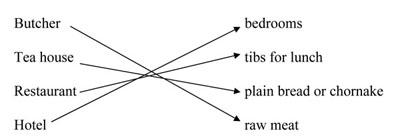
SAQ 11.2 (tests Learning Outcomes 11.1, 11.3 and 11.6)
You are planning to do a sanitary inspection on a tea house. Outline the main areas of your inspection.
Answer
There are several important points to consider when conducting an inspection: condition of buildings, cleanliness of food handling areas, personal hygiene of food handlers, waste disposal, and of course sanitary and washing facilities. You should inspect all of these, but depending on what you find (or what you found if you have inspected this establishment before), you may wish to focus particularly on any one of these if there is a cause for concern.
SAQ 11.3 (tests Learning Outcomes 11.4 and 11.6)
List the components of personal hygiene that need to checked during your inspection of the tea house, and describe the procedures you would use to check them.
Answer
The points you should check with the food handlers are:
- hair hygiene and hair cover
- use of apron, gown or overalls
- fingernail hygiene
- hand hygiene
- presence of active infections.
The first two items could be checked simply by looking from a distance. You would have to examine the food handler’s hands closely to assess the condition of their hands and fingernails, and you should check with them (by interview) that they wash their hands before handling food and after any interruption. To check for active infections you need to look closely at their skin, and check for eye, ear or nose discharges. Can you see or hear them sneezing or coughing? During your interview with them, ask them whether they have diarrhoea, and whether they understand that if they have any infections they should not be handling food.
SAQ 11.4 (tests Learning Outcome 11.5)
During your inspection of the tea house, you learn that at busy times they are catering for more than 50 people. What sanitary facilities must be available?
Answer
The sanitary facilities that should be available for the staff are a handwashing station, latrine, shower and clothes changing cabinet. Additionally there should be one handwashing station and latrine for every 30 clients. Since the tea house can have 50 or more clients at busy times there should be two latrines and handwashing stations. It is better to have separate men’s and women’s facilities.
Appendix 11.1
Suggested sanitary surveillance form for food and drink establishments
| Interviewer’s name: _____________ | Date of interview: _____________ |
| Woreda: _____________ | Kebele: _____________ |
| Name of establishment: ______________________________ | |
| 1 Type of establishment | |
|---|---|
| 1) Hotel | 4) Tej bet |
| 2) Restaurant | 5) Other: |
| 3) Tea house | _________________________________ |
| 2 Licence | |
| 1) Yes | 2) No |
| 3 Water supply | |
| 3.1 Source | 1) Piped private |
| 2) Piped shared | |
| 3) Piped public stand post | |
| 4) Private well, protected | |
| 5) Private well, unprotected | |
| 6) Unprotected source (describe): | |
| _________________________________ | |
| 3.2 Handwashing facilities | 1) Washbasin |
| 2) Water trough | |
| 3) Manual | |
| 4) Other, describe: | |
| _________________________________ | |
| 4 Excreta disposal (for public use only) | |
| 4.1 Is there a latrine? | 1) Yes |
| 2) No | |
| 4.2 Type | 1) Water carriage/flush toilet |
| 2) Dry latrine | |
| 4.3 Number of squatting holes for the above types | _______ |
| 4.4 Does the dry pit latrine have a vent pipe? | 1) Yes |
| 2) No | |
| 4.5 Is there a septic tank? | 1) Yes |
| 2) No | |
| 4.6 Maintenance condition of latrine at the time of visit | 1) Needs minor repair |
| 2) Needs major repair | |
| 3) No need of repair | |
| 4.7 Cleanliness of latrine at the time of visit | 1) Clean and next person can use it |
| 2) Unclean and next person cannot use it | |
| 5 Liquid waste management | |
| 5.1 Where is the wastewater from the hand and dishwashing facilities disposed of? | 1) Septic tank |
| 2) Seepage | |
| 3) Storm pipe | |
| 4) Open ditch | |
| 5) Latrine | |
| 5.2 Are there any insects breeding around the liquid waste facilities? | 1) Yes |
| 2) No | |
| If yes, what vector: | |
| _________________________________ | |
| 5.3 Is there any overflowing liquid waste at the time of inspection? | 1) Yes |
| 2) No | |
| 6 Solid waste management | |
| 6.1 Is there a refuse container for public use? | 1) Yes |
| 2) No | |
| 6.2 Is there a garbage container for kitchen use? | 1) Yes |
| 2) No | |
| 6.3 How is the refuse and garbage finally disposed of? | 1) Burning |
| 2) Refuse pit burial | |
| 3) Open field dumping | |
| 4) Municipal service | |
| 5) Other, specify: | |
| _________________________________ | |
| 7 Equipment washing facilities | |
| 7.1 Dishwashing | |
| 7.1.1 How many containers are used? | 1) One |
| 2) Two | |
| 3) Three | |
| 7.1.2 The above container is: | 1) Fixed type with a water tap |
| 2) Bowls/buckets | |
| 7.1.3 Hot water used for Dishwashing | 1) Yes |
| 2) No | |
| 7.1.4 Detergent used for Dishwashing | 1) Yes |
| 2) No | |
| 7.2 Drinking glass washing facilities | |
| 7.2.1 How many containers are used? | 1) One |
| 2) Two | |
| 3) Three | |
| 7.2.2 The above compartment is: | 1) Fixed type with a water tap |
| 2) Bowls/buckets | |
| 7.2.3 Hot water used for glass washing | 1) Yes |
| 2) No | |
| 7.2.4 Detergent used for glass washing | 1) Yes |
| 2) No | |
| 8 Food handlers’ personal hygiene | |
| Check the following in at least one food handler working in kitchen and dining area: | |
| 8.1 Fingernails cut short | 1) Yes |
| 2) No | |
| 8.2 Hair covered during work | 1) Yes |
| 2) No | |
| 8.3 Finger ornaments worn during work | 1) Yes |
| 2) No | |
| 8.4 Any infection present at a time of visit | 1) Skin (open wound) |
| 2) Respiratory infection | |
| 3) Diarrhoeal infection | |
| 4) Discharge from the eye | |
| 5) Discharge from the nose | |
| 6) Discharge from the ear | |
| 7) Other, specify: | |
| _________________________________ | |
| 8.5 Outer garment (apron/gown) worn? | 1) Yes |
| 2) No | |
| 8.6 Colour of working outer garment | 1) White |
| 2) Blue | |
| 3) Red | |
| 4) Grey | |
| 5) Other, specify: | |
| _________________________________ | |
| 8.7 Is the outer garment visibly dirty? | 1) Yes |
| 2) No | |
| 9 Food servicing hygiene practice | |
| 9.1 When is the food served? | 1) Any time of day |
| 2) At specified times (e.g. for breakfast, lunch and dinner) | |
| 9.2 How are perishable food items stored? | 1) Prepared foods kept in fridges and then served |
| 2) Hot foods served immediately | |
| 3) Food leftovers reheated and served | |
| 4) Other, specify: | |
| _________________________________ | |
| 10 Building conditions | |
| 10.1. Kitchen | |
| 10.1.1 Visible smoke (check the wall and ceiling/roof for smoke particles) | 1) Yes |
| 2) No | |
| 10.1.2 Is there overcrowding? | 1) Yes |
| 2) No | |
| 10.1.3 Handling of foods like injera at the time of visit | 1) Cover |
| 2) No cover | |
| 10.1.4 Presence of vectors | 1) Yes |
| 2) No | |
| If yes, specify: | |
| _________________________________ | |
| 10.2 Dining room | |
| 10.2.1 Walls in good condition | 1) Yes |
| 2) No | |
| 10.2.2 Ceiling in good condition | 1) Yes |
| 2) No | |
| 10.2.3 Adequate lighting | 1) Yes |
| 2) No | |
| 10.2.4 Adequate ventilation | 1) Yes |
| 2) No | |
| 10.2.5 Tables and chairs in good condition | 1) Yes |
| 2) No | |
| 11 Butchery | |
| 11.1 Source of meat (check the presence of municipal stamp) | 1) From Municipality abattoir |
| 2) Private sources | |
| 11.2 Quality of meat on visual inspection (do not touch, but check colour and odour) | 1) Fresh and good |
| 2) Odourous, with discharges | |
| 3) Other, specify: | |
| _________________________________ | |
| 11.3 Knives kept in drawer when not used | 1) Yes |
| 2) No | |
| 11.4 Handwashing facilities present in the vicinity | 1) Yes |
| 2) No | |
| 11.5 Knife washing facilities in the vicinity | 1) Yes |
| 2) No | |
| 11.6 Latrine presence in the vicinity | 1) Yes |
| 2) No | |
| 11.7 Chopping block cleanliness | 1) Clean |
| 2) Unclean | |
| 11.8 Chopping surface cleanliness | 1) Clean |
| 2) Unclean | |
| 11.9 Offal kept separately from the meat | 1) Yes |
| 2) No | |
| 11.10 Vector presence on visual inspection | 1) Yes |
| 2) No | |
| If, yes specify: | |
| _________________________________ | |
| 1.11 Walls in good condition | 1) Yes |
| 2) No | |
| 11.12 Ceiling in good condition | 1) Yes |
| 2) No | |
| 11.13 Adequate lighting | 1) Yes |
| 2) No | |
| 11.14 Adequate ventilation | 1) Yes |
| 2) No | |
| 11.15 Dustbin availability | 1) Yes |
| 2) No | |
| 11.16 Meat wrapped when sold | 1) Yes |
| 2) No | |
Note any unhygienic practices observed and your suggestions:
Unhygienic practices:
- _______________________________________________________
- _______________________________________________________
- _______________________________________________________
- _______________________________________________________
- _______________________________________________________
Suggestions, advice, actions taken
- _______________________________________________________
- _______________________________________________________
- _______________________________________________________
- _______________________________________________________
- _______________________________________________________